Filed under: Analysis, Anarchist Movement, Community Organizing, Featured, Gentrification, Housing, Northwest

On August 24, 2018, Olympia Parks, Recreation and Arts Director, Paul Simmons made the dramatic and near unilateral decision to shutter the Artesian Commons Park. The park is small, asphalt-covered, devoid of green space and features tables, a basketball hoop and the Artesian Well, a natural spring (which remains open). Most notably, and notoriously, the park is an important hangout for street youth and is most illustrative of the crises of homelessness and poverty afflicting Olympia. The Artesian Commons closure decision was issued on the unusual basis that threats from park users had been directed against city staff. The absurdity of such a basis is abundantly clear in the lack of any obvious parallels; sidewalks aren’t closed when muggings, public intoxication, or street harassment are reported, for example.
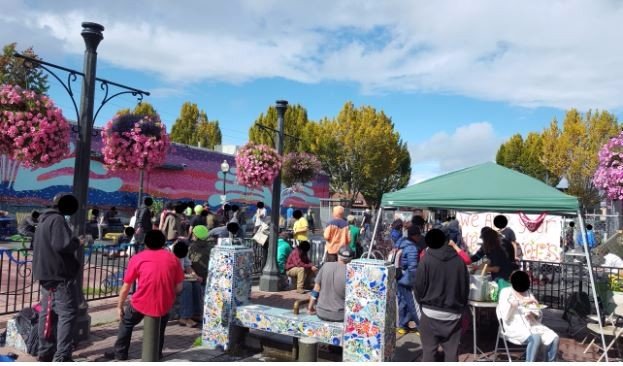 Protesters occupy the closed Artesian Commons
Protesters occupy the closed Artesian Commons
The decision to close the Artesian Park was informed by class and the political pressures of gentrification. In fact, in a follow-up to his original statement, Simmons claimed, with astounding honesty for a bureaucrat, that, “Our parks are supposed to enhance the quality of life for people around them. It’s supposed to make businesses better, it’s supposed to make property values increase. Unfortunately the challenges surrounding this one are doing the opposite.”
A few weeks later on September 22nd, protesters cut locks, tore down the fence and over 100 people subsequently occupied the Commons. Street kids, activists, anarchists, and other community members played basketball, shared a meal from Food Not Bombs, hung banners and streamers and chalked the concrete. In just a few hours this festive and joyful expression of defiance was juxtaposed with riot cops, arrests, pepper balls and concussion grenades. Although obviously outflanked, protesters temporarily re-opened the Commons a second time following initial expulsion and police failed to fully disperse the crowd for hours. Three people were arrested during the protest, a few more would be picked up in its aftermath; others sustained injuries from concussion grenade shrapnel.
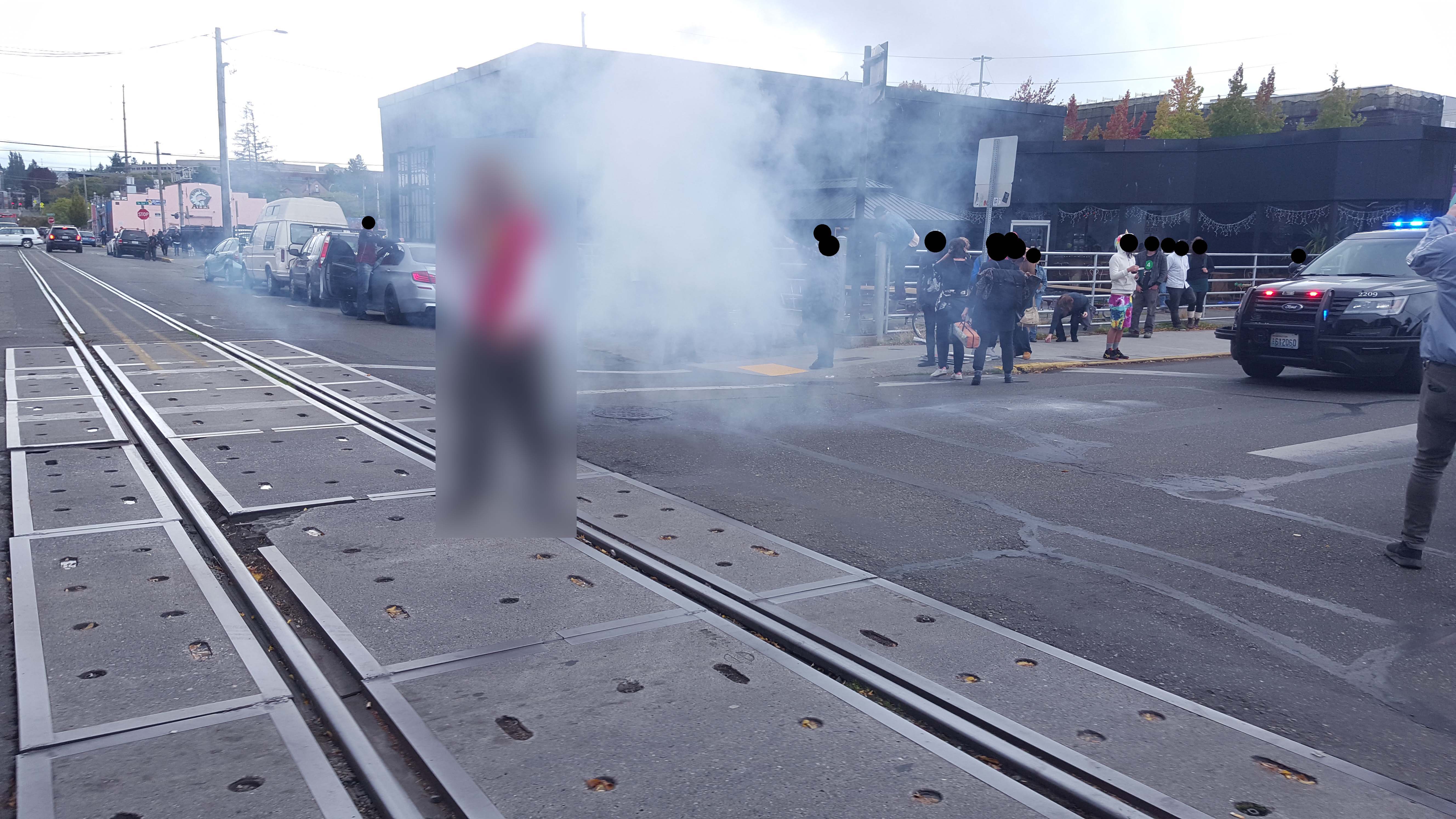 Concussion grenade deployed during the Artesian Commons protest.
Concussion grenade deployed during the Artesian Commons protest.
The Artesian Commons closure and attempts to re-open it with direct action are significant events in a wider historical context of general anti-homeless and criminalizing tendencies in Olympia as well as periodically explosive social conflict over questions of homelessness and public space in the city.
This essay seeks to both analyze homelessness and public space under capitalism generally and in Olympia in particular and provide an historical account of the criminalization of homelessness and struggles for homeless rights. In so doing it is hoped that readers will conclude that conflicts between the homeless and municipal governments and business owners are an often analytically and practically neglected but potent dimension of class struggle found throughout urban capitalism. Moreover, contingent upon that hope is the hope that radicals and leftists will support or join movements in solidarity with the homeless. Despite the fact that homeless individuals compose a fraction of the general population, the class dynamics of homelessness fundamentally characterize the nature of municipal governance and gentrification, and thus have implications for society at large.
Gentrification and the Politics of Public Space
Gentrification is a process of urban and neighborhood change characterized by displacements of established, lower-income residents and (usually) influxes of newer, wealthier residents, with accompanying alterations in racial demographics – people of color are disproportionately displaced by gentrification, often overwhelmingly so -, economic compositions and physical infrastructures. From this definition political conclusions are frequently forged that indict individual consumer habits or entire lifestyle categories, such as that of ‘hipster’ or ‘yuppie.’ While understandable, these assumptions are analytically shallow.
Most fundamentally, gentrification must be understood as a process inherent to capitalism. Under capitalism, the dictates of profit determine all economic decisions, including within the realm of housing. How much housing is built, where it is built, and who it shelters are all decisions made in the interest of profit. Gentrification, at its core, involves fluctuations in levels of capital investments in property markets in given areas, causing some neighborhoods or cities to experience increasing property values and the attendant effects of rising property prices, rents and other basic living expenses, i.e. to “gentrify.” The inverse of increasing investment levels in certain regions occurs simultaneously with disinvestment in other regions, causing areas to experience underdevelopment. This inverted relationship between gentrification and underdevelopment occurs at a range of geographical scales, from that of the metropolitan area to the global level. Property investment flows are mediated and facilitated by states which encourage gentrification in the respective territories they govern as a means to stabilize economies, increase profit rates and secure sources of taxation and revenue. Governments offer tax credits and subsidies to developers and, as discussed below, actively criminalize marginalized residents and certain behaviors while enclosing and policing public space in an effort to make areas more attractive to investors.
“While rarely owned by private enterprise or utilized as sites of direct profit realization, public space is governed according to the interests of the state, which in turn reproduces itself by protecting the interests of capital within particular geographic territories.”
‘Public space’ refers to places relatively open and accessible such as parks, public bathrooms, public libraries, sidewalks or squares. Public spaces are usually owned and managed by municipal governments, although some are ‘privately owned public space’ (POPS). While rarely owned by private enterprise or utilized as sites of direct profit realization, public space is governed according to the interests of the state, which in turn reproduces itself by protecting the interests of capital within particular geographic territories. Public space according to the dictates of private business and the state exists to ensure consumption in the formal economy. These interests exist in sharp tension with the reality of public space’s uses, which are varied and contradictory. Along with formal workers and consumers utilizing public space to access their respective workplaces and sources of goods and services, public space is also utilized as living space, locations for subsistence in informal economies and sites of subcultural expression. Homeless people use public spaces, such as benches and parks as dwelling space, skaters, punks and others use squares as sites of recreation and lifestyle experimentation, and street vendors, sex workers and drug traffickers and others in the informal economy use sidewalks as sites to procure an income.
In the context of gentrification, with increased investment and commerce in formerly underdeveloped areas, an ever greater emphasis is afforded to efforts to police certain behaviors and activities and the people who exhibit them in public space. Municipalities increasingly enact and enforce ordinances and regulations that criminalize public camping, loitering, sleeping on benches or in cars, skateboarding, or smoking in public. Moreover, public spaces are increasingly inaccessible or being removed entirely, from the shuttering of public bathrooms to park curfews and removal of benches.
The Particularities of Olympia
Olympia is currently experiencing waves of gentrification and property investment. As property values increase, area rents and home prices skyrocket, and with them general price inflation. While this phenomenon is increasingly geographically widespread throughout the whole city, property investment remains particularly concentrated in the downtown core. Downtown Olympia is distinct from many urban centers with its relatively low quantity of housing. Downtown is also somewhat distinct with its highly visible and concentrated homeless population, estimated to be in the hundreds in the daytime. Although downtown is amidst a luxury development boom, most construction is occurring on previously vacant lots. Thus these developments are not directly displacing lower-income renters through the redevelopment of low-cost housing (though they contribute to displacement indirectly because such large influxes of investment in property markets leads to near universal property value increases in a given region.) Like elsewhere, the city government incentivizes luxury development through tax credit schemes.
Along with luxury developers, business owners, their political front groups and the municipal government are also fundamental agents of gentrification in Olympia. These actors seek to boost commerce in the downtown core through a range of initiatives. There is a push to orient Olympia’s economy towards tourism through various municipal-sponsored projects, such as the bi-annual ArtsWalk events and promotion of cultural activities at Percival Landing Park, while other parks and public spaces are neglected. The business front group, Olympia Downtown Alliance (ODA), hosts “Third Thursday” monthly business booster events, lobbies for pro-business policies and provides technical assistance to member businesses.
The most conflictual component to gentrification in Olympia, however, has been over questions of public space and the intimately related efforts on behalf of the municipal government and business owners to criminalize and displace homeless individuals. As noted earlier, downtown is home to a visible and concentrated population of hundreds of homeless people. The homeless presence downtown is an obstacle to gentrification in Olympia (and elsewhere) for a number of reasons. Firstly, anti-homeless prejudice runs exceptionally deep, despite the fact that huge swathes of American society currently are or are on the brink of experiencing housing instability. Olympia is no exception to this trend, with many residents reporting to business owners that they refuse to even venture downtown due to homelessness. Secondly, many homeless people seek daytime shelter in warm businesses and nighttime shelter in the alcoves of storefronts. Business owners have a material interest in banning or displacing homeless people from establishments simply on the basis that they don’t consume commodities at the same rate as housed people. Thirdly, municipalities, Olympia or otherwise, also have a material interest in displacing homeless people in an effort redirect funding from social services into more promising revenue-generating investments.
The City of Olympia actively criminalizes homelessness through the enforcement of a number of ordinances and codes. A No Sit/Lie ordinance prohibits loitering, a camping ban forces people out of parks and off sidewalks and a range of parking regulations effectively bars sleeping in vehicles. The city government vigorously enforces obscure codes against property owners that are seen as too homeless-friendly. Property owners who allow homeless people to sleep on their property are targeted by code-enforcement for allowing sub-standard shelters (lack of sanitation, running water etc.) on their property. Moreover, social services are dismal. The discrepancy between the number of shelter beds available and those in need continues to increase. What services are provided, either via the municipal government or non-profits, are constantly under threat of closure due to financial difficulties or political pressure.
On the Offensive: Current Homeless Solidarity Movements and Battles for Public Space
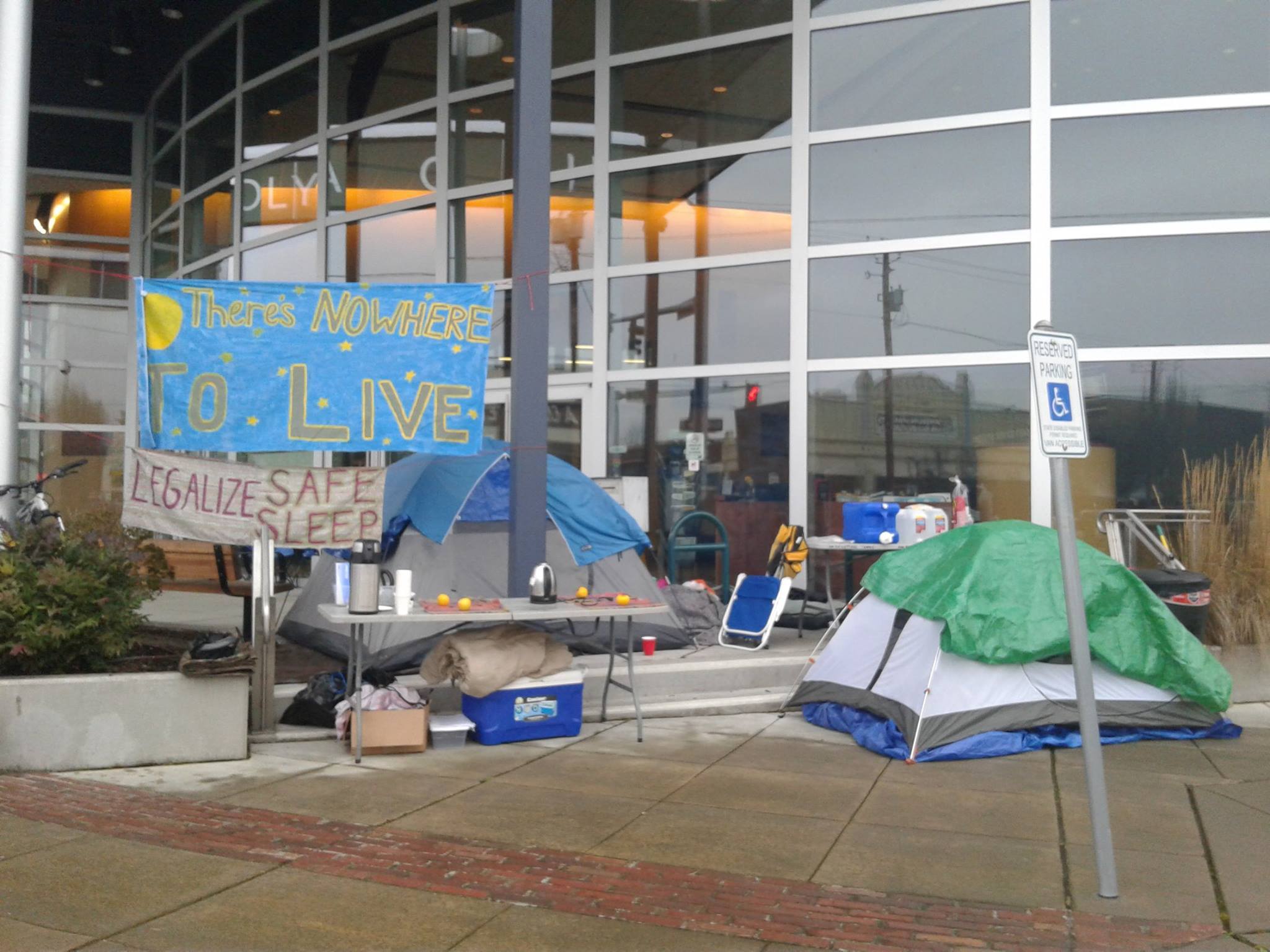 Just Housing-hosted “camp-in” in front of Olympia City Hall
Just Housing-hosted “camp-in” in front of Olympia City Hall
Olympia has witnessed an impressive historical array of homeless solidarity and public space struggles, now spanning decades. From illicit mutual aid projects such as needle exchanges, to occupations of parks and parking lots that forced the development of affordable housing and limited legal camping options, struggle on the terrain of public space has been perhaps the definitive feature of class conflict and anti-gentrification resistance in Olympia.
Like in other locales, political activity in Olympia vacillates, with periods of heightened struggle often followed by significant lulls. Currently, conflicts over homelessness/public space are assuming explosive dimensions. As noted earlier, the battle for the Artesian Commons has recently caught headlines, but it is merely the tip of the iceberg. It is occurring within a wider context of struggles against anti-homeless municipal ordinances, campaigns against private security contracts, anti-eviction camp defense and new mutual aid projects. To adequately understand the current moment, it is necessary examine more closely its foundational preceding years.
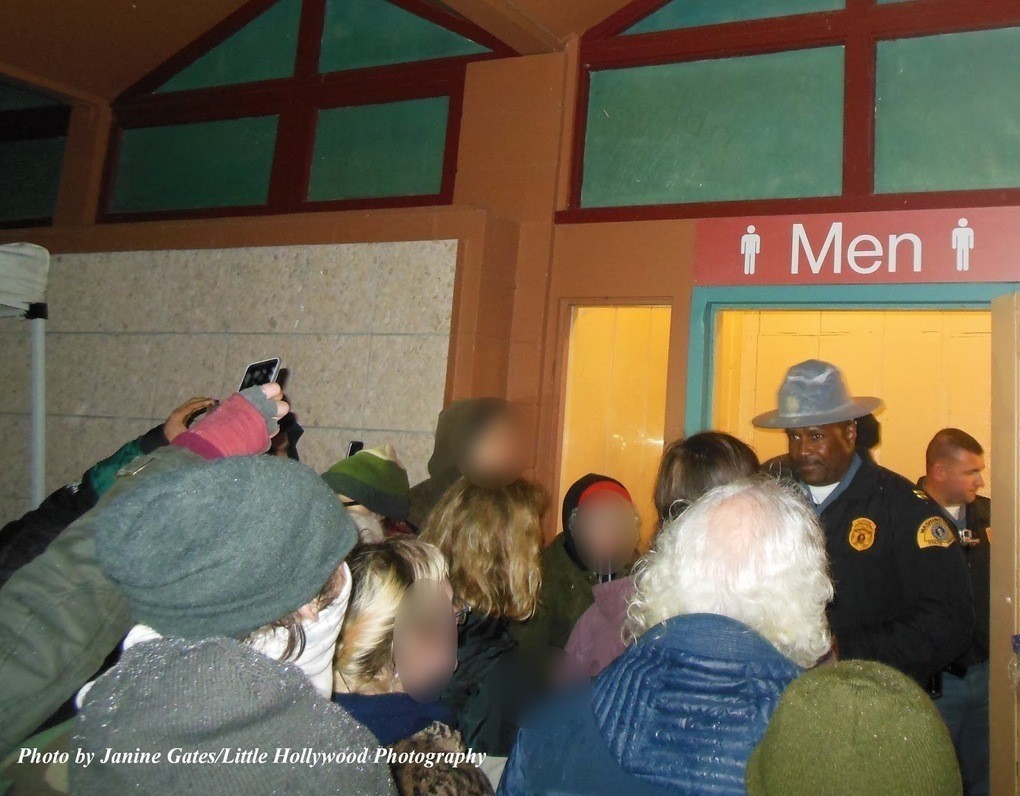 Protesters confront WA State Patrol during the Heritage Park bathroom occupations
Protesters confront WA State Patrol during the Heritage Park bathroom occupations
Although homeless solidarity is a relatively consistent political issue in Olympia, efforts have been progressively intensifying over the past two years. This in large part is owed to the efforts of Just Housing (JH). JH was formed in the autumn of 2016, with a politically loose but solid base of homeless individuals, disaffected social workers, students and others. Initially, JH organized weekly city council speak-outs, an important popular education endeavor. During the last few days of 2016, JH staged direct actions on three consecutive evenings, boosting the organization’s profile immensely. Protesters occupied the Heritage Park public bathrooms after hours, in an attempt to force their operation on a 24/7 basis. The protests provoked significant police response, leading to arrests, minor scuffles and the use of the dispersal weapon, pepper balls. The bathroom occupations concluded in the partial victory of the installation of 24/7 port-a-potties adjacent to the brick and mortar bathrooms. Soon after, JH launched a series of demonstrations against the downtown location of Olympia Federal Savings after the bank evicted a small encampment on its property. For the following 6 months, JH hosted dozens of camp-ins, sometimes combined with anti-eviction camp defenses, in defiance of Olympia’s public camping ban. During this time JH continued to consistently engage in advocacy and popular education.
 Protesters block OlyFed bank entrance
Protesters block OlyFed bank entrance
For approximately the last year JH’s strategic orientation has shifted away from direct action and more exclusively to mutual aid and advocacy. Much emphasis has been afforded to encampment support, such as weekly garbage collections and needle exchanges. Numerous meaningful relationships with camp residents have been forged, allowing more homeless people to directly participate in organizing projects. Due to heightened public support and the threat of further direct action, JH has been able, at times, to directly intervene in municipal policy changes. Many alterations to the Tent City Ordinance were permitted upon request from JH, for example. While this more recent advocacy-centric approach from JH has led to tangible improvements for homeless people via policy changes, there is also the clear danger of accommodation that could discourage the very direct action tactics that legitimized JH in the first place.
“struggle on the terrain of public space has been perhaps the definitive feature of class conflict and anti-gentrification resistance in Olympia.”
This short but significant historical dropback lays the foundation for the contradictions and tensions currently flaring. Responses from the City Of Olympia have been inconsistent and internally conflictual. While initially conciliatory, City approaches changed later, as described below. In May, 2018, the Olympia City Council unanimously approved resolutions committing the city to important, though limited reforms, including legal camping options and the implementation of a low-barrier day center. This was followed a couple months later with a unanimous homelessness emergency declaration and a stay on an imminent camp eviction. These relatively progressive council decisions indicated to many that the City was finally on the right track, and attention shifted to the virulently anti-homeless and increasingly combative downtown business class and one of their political front groups, the Olympia Downtown Alliance (ODA).
The Olympia Downtown Alliance engages in “business advocacy” and has been crucial in cohereing the downtown business class’ line on homelessness. The ODA has mobilized for speak-outs at city council meeting and lobbying sessions in an attempt to pressure the city government into halting the development of social services in the downtown core, a strong desire amongst business owners. The most tangible support the ODA has offered business owners was through its Downtown Safety Team initiative. The Downtown Safety Team was a nightly security walking patrol, staffed by Pacific Coast Security and funded through individual contracts from businesses, building owners and property managers participating in the initiative. The nightly patrols trespassed and swept homeless individuals seeking refuge in alcoves and alleyways and was been effective in displacing many in the downtown core. Many of those displaced relocated to the ballooning encampments adaject to Olympia Transit Center.
The Olympia Solidarity Network (OlySol), along with technical assistance and input from CopWatch and other organizations, assumed the initiative in resisting the security patrols. OlySol’s campaign targeted participating businesses, the Olympia Downtown Alliance and Pacific Coast Security itself, with pickets, street theater, poster campaigns, mass copwatch and PCS patrol disruptions, and phone zaps. These were effective in suspending the nightly patrols for 9 days in early October. The resumption of the patrols was accompanied with new security staff, including a regional supervisor. OlySol continued the campaign with more phone zaps and two more disruptions of the nightly patrols. In early December, PCS withdrew from the security scheme, signaling the suspension (and possible end) of the Downtown Safety Team. This victory is an important step forward in efforts to secure safer sleeping options and is testament to the power of collective struggle and direct action.
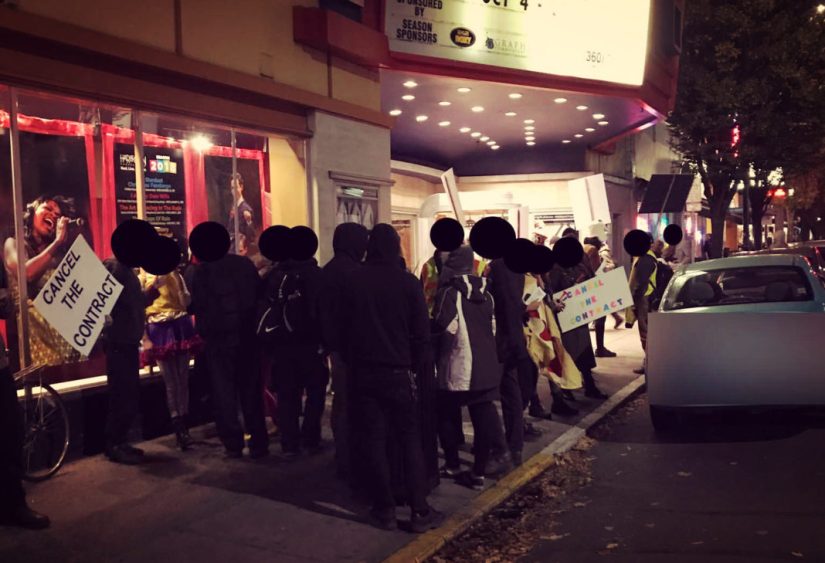 October 4th Picket at Harlequin Productions (a contract holder with PCS)
October 4th Picket at Harlequin Productions (a contract holder with PCS)
More recently, the city government has seemingly committed an about face, taking more repressive and criminalizing measures against the downtown homeless population. Firstly, attempts were made to evict three large downtown encampments. All of these eviction attempts were indefinitely stayed due to the potential legal implications of the Martin V. City of Boise case of the Court of Appeals for the Ninth Circuit. Secondly, the city temporarily intensified enforcement of the No Sit/Lie anti-loitering ordinance leading to a few arrests. Thirdly, this all occurred approximately in tandem with the Artesian Commons closure, noted in detail earlier. Significantly, these decisions were issued by city bureaucrats with minimal or no consultation from elected city council members, generating internal political conflict.
A variety of actions were taken in response. Graffiti proliferated throughout downtown condemning the Artesian Commons closure and banners were draped on the fence erected at the Commons. In early September a small sit-in was staged on the sidewalk in defiance of the No Sit/Lie ordinance. Days following, a larger rally and march to city hall was organized by Just Housing and OlySol, with a subsequent speak-out at the city council meeting and large mutual aid event outside city hall. This demonstration leveled three demands on the City of Olympia: 1.) Re-open the Artesian Commons 2.) Repeal the No Sit/Lie ordinance 3.) Repeal the public camping ban. Finally, on September 22nd, as described in the introduction, the Artesian Commons was temporarily re-opened in a large direct action that was violently repressed by police.
Much of September’s organizing was informed by knowledge of the internal political conflict affecting the city government. It was hoped that protests would exacerbate divisions between city council member and city staff and bureaucrats and compel the council to react favorably through legislation. Unfortunately, this strategy was fruitless; city council made little gestures towards satisfying the demands. The optimism afforded to an advocacy/legislative approach was unfounded and proved ultimately a distraction. A more focused, direct action-informed strategic orientation could have yielded better results.
A community struggle to reclaim a fenced off park in #Olympia led police to turn the Downtown into a war zone. "The street was again cleared with concussion grenades and pepper balls…Another person was also beaten by police…" https://t.co/NPfFH3sQiZ pic.twitter.com/pTP6bBzFOn
— It's Going Down (@IGD_News) September 25, 2018
As autumn progressed the political terrain upon which homeless solidarity movements operate has only grown more complex and unpredictable. The City of Olympia, bounded by the contradiction of maintaining an anti-camping ordinance but also simultaneously subject to the Ninth Circuit Court ruling charging such ordinances unconstitutional, is currently trying to skirt legal scrutiny through the development of “mitigation sites.” Mitigation sites will be relatively controlled and managed camping areas on public property. Many details are lacking as of this writing, with only one site under construction at the parking lot located at Olympia Ave/Franklin St. However, there is widespread concern that the existence of mitigation sites could be used as a basis for displacement from non-sanctioned public property sites, though this too could be in violation of the court ruling.
The current state of effectively decriminalized camping on city property has only contributed to the furious anti-homeless class hatred of the downtown business class. Some of this fury is now being directed towards the city government. A crew of business owners are contemplating suing the city government for “damages” caused by the City’s response to homelessness, namely over the enforcement of the camping ban. At a recent meeting of these downtown business owners, a homeless advocate slipped into the meeting and apparently was subsequently confronted and physically assaulted by a couple of business owners. While these growing cleavages between the downtown business class and the city government present opportunities for social gains, the increasing vulnerability afforded to both players could also entail adverse consequences, from heightened police repression to vigilante harassment or violence.
Anti-authoritarian and anti-capitalist groups in #Olympia holding "Mutual Aid Mondays" every Monday at 7pm. pic.twitter.com/jZfqe2raiR
— It's Going Down (@IGD_News) November 14, 2018
On a concluding note, mutual aid efforts have strengthened. The Olympia Community Medics, which was formed through a seasonal popular assembly hosted by Olympia Assembly, organizes routine provisioning of medical and hygiene supplies to homeless individuals and seeks to coordinate a network of first-aid trained downtown workers and residents who can respond to drug overdoses or other emergencies without police interference. A collaborative effort has been forged by OlySol, Olympia Community Medics, Just Housing, Olympia Assembly and Olympia IWW for the recurring Mutual Aid Mondays. Every Monday for the past 2 months, food, clothing, hygiene and medical supplies have been distributed, primarily at the largest downtown encampment on State Ave. and Franklin St., but also at other downtown locations. This increased mutual aid activity complements the much older and very consistent work of Olympia Food Not Bombs, Emma Goldman Youth and Homeless Outreach Project (EGYHOP), and Just Housing’s Rolling Refuse Removal garbage collection initiative.
Moving Forward: Consistency and Organization in Direct Action and Mutual Aid
Direct action tactics have frequently been deployed in in the recent upsurge of Olympia homeless solidarity organizing. However, this deployment has occurred outside of a coherent strategic framework, often lacking consistency, organization and focused escalation. While the dramatic protest to re-open the Commons was an important display of popular discontent and should not be discounted, the informal and inconsistent nature of organizing around the park is likely partly to blame for a lack of follow through. On the other hand, Olympia Solidarity Network, with its organizational commitment to consistent action and strategic escalation, and maintenance of a strong mobilization infrastructure, was effective in suspending the anti-homeless security scheme mentioned earlier. Either way, as it is clear that Olympia politicians and bureaucrats continue to drag their feet on important policy questions and the downtown business class grows more steadfast in its anti-homeless bigotry, a primacy must be placed on direct action moving forward.
Mutual aid too must maintain its centrality to our strategic orientation. Mutual aid projects can meet material needs, expose the inabilities of the market and the state to mitigate inequalities and strengthen personal and political relationships across a range of differences. As social services are gutted, homeless and other marginalized populations are increasingly vulnerable and susceptible to the pressures of displacement. By filling a resource void left by the state, mutual aid projects can become a form of direct resistance to displacement.
Mutual Aid Mondays, EGYHOP, Olympia Food Not Bombs and Rolling Refuse Removal are all highly consistent and decently organized. Increased efforts should be devoted to further politicizing these projects, seeking to transform them into sites of direct political organizing as well as sites of grassroots service provision. This could assume a range of forms, from heightened attempts at information-sharing and literature distribution (Food Not Bombs already does this) to hosting skill shares or small meetings and assemblies at provision locations.
-
For the Simmons quote: https://www.kiro7.com/news/local/threats-and-violence-force-city-to-close-artesian-commons-park-in-olympia/819970711
-
Info on Artesian Commons protest: https://itsgoingdown.org/the-struggle-for-the-artesian-well-in-olympia-wa/
-
For more on the political economy of gentrification the following texts are recommended: Short Circuit: An Anarchist Approach to Gentrification, The New Urban Frontier by Neil Smith and In Defense of Housing by David Madden and Peter Marcuse.
-
For more on the politics of public space check out: The Right to the City: Social Justice and the Fight for Public Space by Don Mitchell.
-
On the OlySol campaign: https://olyassembly.org/2018/12/05/pacific-coast-security-withdraws-from-anti-homeless-security-scheme/
https://itsgoingdown.org/olympia-campaign-advances-through-direct-action-mutual-aid/
https://itsgoingdown.org/protest-zap-disrupt-olysol-campaign-expands-against-displacement/
6. On the court ruling and park closure:
https://itsgoingdown.org/olympia-anger-grows-as-city-comes-down-on-homeless/
7. On mitigation sites: https://www.king5.com/article/news/local/homeless/olympia-tries-new-approach-to-homelessness/281-613147782
8. Learn more about Olympia mutual aid!
https://olyassembly.org/2018/11/27/mutual-aid-mondays/





